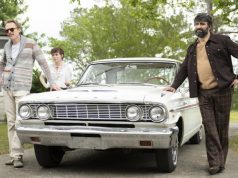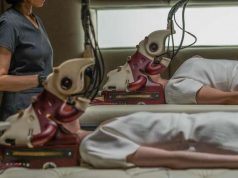George Romero’s obsession with zombies has made him the undisputed godfather of undead cinema. His “Night of the Living Dead” defined the genre 40 years ago and spawned countless imitators, and while some of those pretenders have done well, you can always tell who they’re copying. There’s nothing quite like a George Romero zombie flick: audacious, funny, horrific, and full of embarrassingly bad writing.
“Diary of the Dead,” Romero’s fifth entry in the catalog, offers a modern twist, and you can feel the 68-year-old perpetual outsider struggling to keep up with a genre that has in many ways hurried past him. This time the action is viewed entirely through the video cameras of the characters, film students documenting the zombie apocalypse and subsequently uploading it to the Internet.
The director is Jason (Joshua Close), a strident, serious kid who’s shooting a cheesy student film at University of Pittsburgh when the dead begin to rise. The first incident occurs live on a cable news channel, caught in the background as a reporter stands in front of a murder scene. (When a dog bites a man, that’s not news. When a murder victim rises from the stretcher and bites a paramedic’s neck, that’s news.) Jason and his compatriots hop in an RV and head for home, figuring there will be safety with their families, and Jason obtrusively puts his camera in his friends’ faces along the way, wanting to capture their thoughts and emotions.
Jason’s girlfriend, Debra (Michelle Morgan), quickly gets tired of his screwed-up priorities, and their pal Tony (Shawn Roberts) must fulfill most of the regular boyfriend duties (comforting, protecting, etc.), as Jason’s always got that camera glued to his face. (That is a hint at the movie’s Major Important Message.) Their fellow travelers aren’t worth mentioning, except for the boozy old professor named Maxwell (Scott Wentworth), whose alcoholic apathy and penchant for pithy, cynical remarks are so over-the-top it’s hard to tell whether Romero intended for the character to be as funny as he is. I think some of his ramblings were supposed to be insightful.
The usual zombie predicaments arise, and here Romero proves he has not lost any of his scary-making skills. I’m impressed by the fact that, five movies in, he can still come up with interesting and entertaining ways of inflicting violence, both on the living and the dead. The way the deaf Amish guy dispatches a flesh-eater is ingenious (yeah, there’s a deaf Amish guy in the movie), and I seem to recall another zombie’s eyes exploding out of his head.
But having committed to the gimmick of telling the entire story through footage shot by the characters (the same formula used in “Cloverfield”), Romero almost immediately starts cheating and finding ways around it. The group finds a second video camera, for example, and it’s obvious the only reason is so that Romero can shoot conversations the normal, cinematic way, cutting back and forth between angles. The students have extraordinary access to surveillance cameras and the like, too, and incorporate it into their own project with amazing speed and dexterity. Jason is able to do an editing project in a few seconds that should have taken all afternoon — all so that Romero can stay within the limitations he imposed on himself.
Romero’s satirical target this time is the media. TV news distorts the truth about the zombie outbreak, so it befalls the YouTubers and the bloggers to set the record straight. But is this infatuation with do-it-yourself filmmaking healthy? Romero makes his point — ham-fistedly, as usual — by having a character hand over a gun to someone, saying, “You take this. It’s too easy to use” — and then repeating the same dialogue later, this time referring to a video camera. Ooh, heavy.
Yes, as always, Romero is great with the horror stuff, he has a lot of terrific ideas … and then he louses it up with hammy, unsophisticated writing and significant plot holes. If he ever made use of a good script doctor, he’d have a combination of satire, scares, and gore that would be hard to beat. As it is, we have to settle for an imperfect, rough-around-the-edges B movie — which, after all, might be part of the charm. Maybe a smooth and accomplished Romero movie wouldn’t be as much fun.
B (1 hr., 34 min.; )





